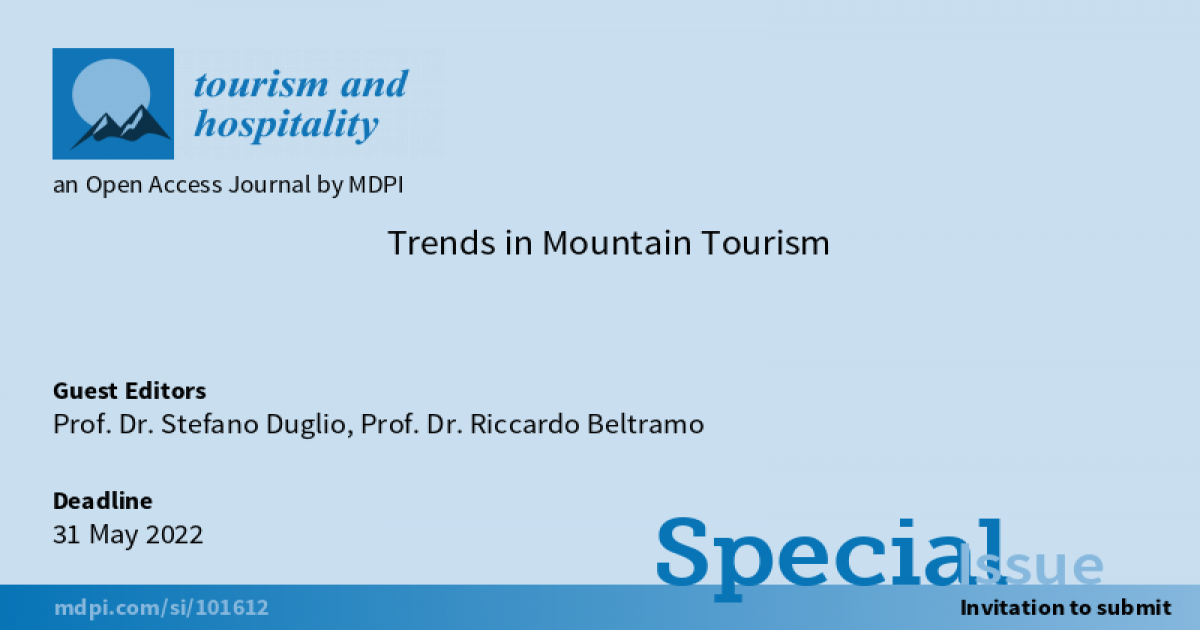Trends in Mountain Tourism
A special issue of Tourism and Hospitality (ISSN 2673-5768).
Deadline for manuscript submissions: closed (31 May 2022) | Viewed by 981

Special Issue Editors
Interests: mountain tourism; sustainable tourism; sport tourism; environmental management
Special Issues, Collections and Topics in MDPI journals
Interests: environmental management systems; industrial ecology; industrial symbiosis and “APEA”; tourism eco-management; Internet of Things (IoT)
Special Issues, Collections and Topics in MDPI journals
Special Issue Information
Dear Colleagues,
Mountains are found on every continent, covering about 24% of the world’s land surface across 139 nations [1], and account for about 15% of worldwide tourism. Due to the diversified range of tourists’ needs and expectations that mountains are able to meet [2], mountains are currently the second most popular type of tourism destination in the world [3].
Mountain tourism is closely connected with the geographical, climatic, and ecological, but also social and economic contexts that make up a tourism destination, which can be defined as the geographical, economic and social assemblages designed for tourists in relation to mountain infrastructures [4,5]. For instance, with over 600 ski resorts in France, Switzerland, Austria and Italy [6] and more than 10,000 lifts [7], tourism in the European Alps is closely associated with ski-related activities. In contrast, tourism in the Himalayan range tends to be associated with hiking and mountaineering activities due to the presence of the highest peaks in the world. In both cases, however, tourism plays an important role in local economies and sustaining Indigenous communities.
Mountains are nevertheless facing important challenges that will serve to transform mountain tourism for the coming years. The first such challenge is climate change, which is threatening winter seasons—especially when considering low-altitude mountain resorts [8], which are forced to make investments in adaptive strategies (e.g. snowmaking) in order to maintain their viability.
Secondly, overtourism. Even in the same mountain destinations, the presence of tourism is not homogeneous. With more than 100 million tourists each year [9], the European Alps are one of the most-visited mountain chains in the word, but while there are some very popular alpine areas, others are hardly visited at all. While the former need to cope with the environmental impacts of the tourism activities they host, the latter receive few economic benefits from the tourism sector [10].
Thirdly, the digital divide. In an increasingly interconnected economic system, social media (e.g., TripAdvisor) and the Worldwide Web play a fundamental role in influencing tourists’ behavior [11]. Nevertheless, many peripheral areas are experiencing a technological gap that makes it difficult to fulfil tourists’ demands.
Finally, the COVID-19 pandemic crisis will have major consequences on the tourism sector that are presently subject to investigation by both policy makers and scholars.
These factors, alone or interconnected, define new trends which could profoundly transform mountain tourism in the coming years.
This Special Issue aims to discuss the complex relationship between mountain regions and tourism. It welcomes theoretical and methodological approaches as well as research results and applications, particularly those focused on the new trends conditioned by the above-mentioned drivers.
Papers selected for this Special Issue will be subject to a rapid but highly robust peer review procedure with the aim of rapid and wide dissemination of research results.
References
- Richins, H.; Johnsen, S.; Hull, J.S. Overview of mountain tourism: Substantive nature, historical context, areas of focus. In Mountain Tourism: Experiences, Communities, Environments and Sustainable Futures. Richins, H., Hull, J.S., Eds. CAB International: Oxon, UK. 2016, pp. 1–12.
- Duglio, S.; Letey, M. The role of a national park in classifying mountain tourism destinations: An exploratory study of the Italian Western Alps. Mt. Sci. 2019, 16, 1675–1690.
- Charters, T.; Saxon, E. Tourism and mountains: A practical guide to managing the environmental and social impacts of mountain tours; UNEP Division of Technology, Industry and Economics (DTIE): UNEP: Paris, France, 2007; ISBN 978-92-807-2831-6.
- Flagestad, A.; Hope, C.A. Strategic success in winter sports destinations: A sustainable value creation perspective. Tour. 2001, 22, 445–461.
- Kuščer, K.; Mihalič, T.; Pechlaner, H. Innovation, sustainable tourism and environments in mountain destination development: A comparative analysis of Austria, Slovenia and Switzerland. Sustain. Tour. 2017, 25, 489–504.
- Abegg, B.; Agrawala, S.; Crick, F.; de Montfalcon, A. Climate Change in the European Alps: Adapting Winter Tourism and Natural Hazards Management, OECD: Paris, France, 2007.
- Vanat, 2020 International report on snow & mountain tourism. Overview of the key industry figures for ski resorts, 12th ed. April 2020, ISBN 978-2-9701028-7-8.
- Falk, M.; Vanat, L. Gains from investments in snowmaking facilities. Econ. 2016, 130, 339–349.
- World Wide Fund for Nature—WWF The European Alps. 2019. Available online: http://wwf.panda.org/knowledge_hub/where_we_work/alps/ (accessed on 16 September 2020).
- Capocchi, A.; Vallone, C.; Pierotti, M.; Amaduzzi, A. Overtourism: A literature review to assess implications and future perspectives. Sustainability 2019, 11, 3303.
- Van der Zee, E.; Bertocchi, D.; Vanneste, D. Distribution of tourists within urban heritage destinations: A hot spot/cold spot analysis of TripAdvisor data as support for destination management. Curr. Issues Tour. 2020, 23, 175–196.
Prof. Dr. Stefano Duglio
Prof. Dr. Riccardo Beltramo
Guest Editors
Manuscript Submission Information
Manuscripts should be submitted online at www.mdpi.com by registering and logging in to this website. Once you are registered, click here to go to the submission form. Manuscripts can be submitted until the deadline. All submissions that pass pre-check are peer-reviewed. Accepted papers will be published continuously in the journal (as soon as accepted) and will be listed together on the special issue website. Research articles, review articles as well as short communications are invited. For planned papers, a title and short abstract (about 100 words) can be sent to the Editorial Office for announcement on this website.
Submitted manuscripts should not have been published previously, nor be under consideration for publication elsewhere (except conference proceedings papers). All manuscripts are thoroughly refereed through a single-blind peer-review process. A guide for authors and other relevant information for submission of manuscripts is available on the Instructions for Authors page. Tourism and Hospitality is an international peer-reviewed open access quarterly journal published by MDPI.
Please visit the Instructions for Authors page before submitting a manuscript. The Article Processing Charge (APC) for publication in this open access journal is 1200 CHF (Swiss Francs). Submitted papers should be well formatted and use good English. Authors may use MDPI's English editing service prior to publication or during author revisions.
Keywords
- mountain tourism
- mountain heritage
- mountain tourism destinations
- hospitality sector in mountain areas
- mountain resorts in the era of climate change
- overtourism in mountain areas and its environmental and social impacts
- mountain tourism and the COVID-19 pandemic crisis
- mountain tourism and the Worldwide Web





